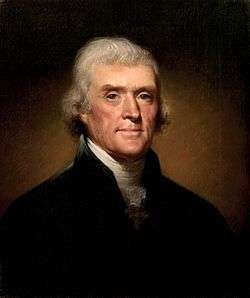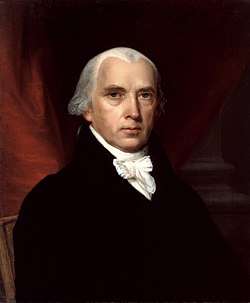James Madison
James Madison Jr. (March 16, 1751[lower-alpha 2] – June 28, 1836) was an American statesman, diplomat, expansionist, philosopher and Founding Father who served as the fourth president of the United States from 1809 to 1817. He is hailed as the "Father of the Constitution" for his pivotal role in drafting and promoting the Constitution of the United States and the United States Bill of Rights. He co-wrote The Federalist Papers, co-founded the Democratic-Republican Party, and served as the fifth United States secretary of State from 1801 to 1809.
James Madison | |
|---|---|
(c).jpg) | |
| 4th President of the United States | |
| In office March 4, 1809 – March 4, 1817 | |
| Vice President |
|
| Preceded by | Thomas Jefferson |
| Succeeded by | James Monroe |
| 5th United States Secretary of State | |
| In office May 2, 1801 – March 3, 1809 | |
| President | Thomas Jefferson |
| Preceded by | John Marshall |
| Succeeded by | Robert Smith |
| Member of the U.S. House of Representatives from Virginia's 15th district | |
| In office March 4, 1793 – March 4, 1797 | |
| Preceded by | Constituency established |
| Succeeded by | John Dawson |
| Member of the U.S. House of Representatives from Virginia's 5th district | |
| In office March 4, 1789 – March 4, 1793 | |
| Preceded by | Constituency established |
| Succeeded by | George Hancock |
| Delegate to the Congress of the Confederation from Virginia | |
| In office November 6, 1786 – October 30, 1787 | |
| Preceded by | Seat established |
| Succeeded by | Cyrus Griffin |
| In office March 1, 1781 – November 1, 1783 | |
| Preceded by | Seat established |
| Succeeded by | Thomas Jefferson |
| Personal details | |
| Born | March 16, 1751 Port Conway, Virginia, British America |
| Died | June 28, 1836 (aged 85) Montpelier, Virginia, U.S. |
| Cause of death | Congestive heart failure |
| Resting place | Montpelier, Virginia, U.S. 38°13′07.5″N 78°10′06.0″W |
| Political party | Democratic-Republican |
| Spouse(s) | |
| Children |
|
| Parents |
|
| Education | College of New Jersey (renamed Princeton) |
| Signature | |
| Military service | |
| Allegiance | Virginia |
| Branch/service | Virginia Militia |
| Years of service | 1775 |
| Rank | Colonel |
Born into a prominent Virginia planter family, Madison served as a member of the Virginia House of Delegates and the Continental Congress during and after the American Revolutionary War. He became dissatisfied with the weak national government established by the Articles of Confederation and helped organize the Constitutional Convention, which produced a new constitution to supplant the Articles of Confederation. Madison's Virginia Plan served as the basis for the Constitutional Convention's deliberations, and he was one of the most influential individuals at the convention. Madison became one of the leaders in the movement to ratify the Constitution, and he joined with Alexander Hamilton and John Jay in writing The Federalist Papers, a series of pro-ratification essays that was one of the most influential works of political science in American history.
After the ratification of the Constitution, Madison emerged as an important leader in the United States House of Representatives and served as a close adviser to President George Washington. He was the main force behind the ratification of the United States Bill of Rights, which enshrines guarantees of personal freedoms and rights within the Constitution. During the early 1790s, Madison came to oppose the economic program and accompanying centralization of power favored by Secretary of the Treasury Alexander Hamilton. Along with Thomas Jefferson, Madison organized the Democratic-Republican Party, which was, alongside Hamilton's Federalist Party, one of the nation's first major political parties. After Jefferson won the 1800 presidential election, Madison served as Secretary of State from 1801 to 1809. In that position, he supervised the Louisiana Purchase, which doubled the size of the United States.
Madison succeeded Jefferson with a victory in the 1808 presidential election. After diplomatic protests and a trade embargo failed to end British attacks against American shipping, he led the United States into the War of 1812. The war was an administrative morass and ended inconclusively, but many Americans saw it as a successful "second war of independence" against Britain. The war convinced Madison of the necessity of a stronger federal government, and he presided over the creation of the Second Bank of the United States and the enactment of the protective Tariff of 1816. Madison's presidency, by treaty or war, added 23 million acres of American Indian land to the United States. He retired from public office in 1817 and died in 1836. Madison was never able to privately reconcile his Republican beliefs and his slave ownership. Madison is considered to be one of the most important Founding Fathers of the United States, and historians have generally ranked him as an above-average president.
Early life and education
James Madison Jr. was born on March 16, 1751, (March 5, 1750, Old Style) at Belle Grove Plantation near Port Conway, Virginia, to James Madison Sr. and Nelly Conway Madison. His family had lived in Virginia since the mid-1600s.[1] Madison grew up as the oldest of twelve children,[2] with seven brothers and four sisters, though only six of his siblings would live to adulthood.[3] His father was a tobacco planter who grew up on a plantation, then called Mount Pleasant, which he had inherited upon reaching adulthood. With an estimated 100 slaves[1] and a 5,000 acres (2,000 ha) plantation, Madison's father was the largest landowner and a leading citizen in the Piedmont. Madison's maternal grandfather was a prominent planter and tobacco merchant.[4] In the early 1760s, the Madison family moved into a newly built house, which they named Montpelier.[3]
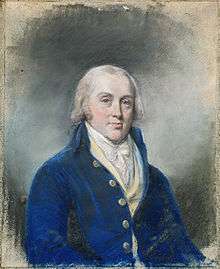
From age 11 to 16, Madison was sent to study under Donald Robertson, a Scottish instructor who served as a tutor for a number of prominent planter families in the South. Madison learned mathematics, geography, and modern and classical languages—he became especially proficient in Latin.[5][6] At age 16, Madison returned to Montpelier, where he began a two-year course of study under the Reverend Thomas Martin in preparation for college. Unlike most college-bound Virginians of his day, Madison did not attend the College of William and Mary, where the lowland Williamsburg climate – thought to be more likely to harbor infectious disease – might have strained his delicate health. Instead, in 1769, he enrolled at the College of New Jersey (renamed Princeton University).[7]
His studies in Princeton included Latin, Greek, theology, and the works of the Enlightenment.[8] Great emphasis was placed on both speech and debate; Madison was a leading member of the American Whig Society, in direct competition to the Cliosophian Society.[9] During his time in Princeton, his closest friend was future Attorney General William Bradford.[10] Along with another classmate, Madison undertook an intense program of study and completed the College of New Jersey's three-year bachelor of arts degree in just two years, graduating in 1771.[11] Madison had contemplated entering into either the clergy or lawyer professions, but declined.[1] He remained at the College of New Jersey to study Hebrew and political philosophy under President John Witherspoon before returning home to Montpelier in early 1772.[12] His ideas on philosophy and morality were strongly shaped by Witherspoon, who converted Madison to the philosophy, values, and modes of thinking of the Age of Enlightenment. Biographer Terence Ball says that at the College of New Jersey:
- He was immersed in the liberalism of the Enlightenment, and converted to eighteenth-century political radicalism. From then on James Madison's theories would advance the rights of happiness of man, and his most active efforts would serve devotedly the cause of civil and political liberty.[13]
After returning to Montpelier, without a chosen career, Madison served as a tutor to his younger siblings.[14] Madison began to study law books on his own in 1773. Madison asked Princeton friend William Bradford, a law apprentice under Edward Shippen in Philadelphia, to send him an ordered written plan on reading law books. At the age of 22, there was no evidence that Madison, himself, made any effort to apprentice under any lawyer in Virginia. By 1783, he had acquired a good sense of legal publications. Madison saw himself as a law student but never as a lawyer – he never joined the bar or practiced. In his elder years, Madison was sensitive to the phrase "demi-Lawyer", or "half-Lawyer", a derisive term used to describe someone who read law books, but did not practice law.[15]
American Revolution
In 1765, the British Parliament passed the Stamp Act, seeking to defray costs of increased imperial administration in British America arising from the French and Indian War by taxing the American colonists. This triggered a two-decade period known as the American Revolution, which began as a dispute between the American colonists and Parliament over the colonies' place within the British Empire. Initially the disagreement regarded whether or not Parliament had the right to levy taxes on the colonists, as they were not directly represented in that body, but events deteriorated until the outbreak of the American Revolutionary War of 1775–83, in which the colonists split into two factions: Loyalists, who continued to adhere to King George III, and the Patriots, whom Madison joined, under the leadership of the Continental Congress. Madison believed that Parliament had overstepped its bounds by attempting to tax the American colonies, and he sympathized with those who resisted British rule.[16] He also favored disestablishing the Anglican Church in Virginia; Madison believed that an established religion was detrimental not only to freedom of religion, but also because it encouraged closed-mindedness and unquestioning obedience to the authority of the state.[17]
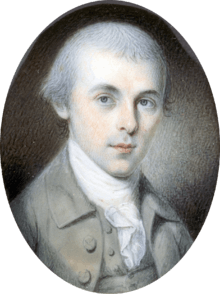
In 1774, Madison, took a seat on the local Committee of Safety, a pro-revolution group that oversaw the local Patriot militia.[18] In October 1775, he was commissioned as the colonel of the Orange County militia, serving as his father's second-in-command until his election as a delegate to the Fifth Virginia Convention, which was charged with producing Virginia's first constitution.[19] Of short stature and frequently in poor health, Madison never saw battle in the Revolutionary War, but he rose to prominence in Virginia politics as a wartime leader.[20]
At the Virginia constitutional convention, he convinced delegates to alter the Virginia Declaration of Rights to provide for "equal entitlement," rather than mere "tolerance," in the exercise of religion.[21] With the enactment of the Virginia constitution, Madison became part of the Virginia House of Delegates, and he was subsequently elected to the Virginia governor's Council of State.[22] In that role, he became a close ally of Governor Thomas Jefferson.[23] On July 4, 1776, the Declaration of Independence was published formally declaring 13 American states an independent nation, no longer under the Crown or British rule.
Madison served on the Council of State from 1777 to 1779, when he was elected to the Second Continental Congress, the governing body of the United States.[lower-alpha 3] The country faced a difficult war against Great Britain, as well as runaway inflation, financial troubles, and lack of cooperation between the different levels of government. Madison worked to make himself an expert on financial issues, becoming a legislative workhorse and a master of parliamentary coalition building.[18] Frustrated by the failure of the states to supply needed requisitions, Madison proposed to amend the Articles of Confederation to grant Congress the power to independently raise revenue through tariffs on foreign imports.[25]
Though General George Washington, Congressman Alexander Hamilton, and other influential leaders also favored the amendment, it was defeated because it failed to win the ratification of all thirteen states.[26] While a member of Congress, Madison was an ardent supporter of a close alliance between the United States and France, and, as an advocate of westward expansion, he insisted that the new nation had to assure its right to navigation on the Mississippi River and control of all lands east of it in the Treaty of Paris that ended the Revolutionary War.[27] After serving Congress from 1780 to 1783, Madison won election to the Virginia House of Delegates in 1784.[28]
Father of the Constitution
Calling a convention
As a member of the Virginia House of Delegates, Madison continued to advocate for religious freedom, and, along with Jefferson, drafted the Virginia Statute for Religious Freedom. That amendment, which guaranteed freedom of religion and disestablished the Church of England, was passed in 1786.[29] Madison also became a land speculator, purchasing land along the Mohawk River in a partnership with another Jefferson protege, James Monroe.[30]
Throughout the 1780s, Madison advocated for reform of the Articles of Confederation. He became increasingly worried about the disunity of the states and the weakness of the central government after the end of the Revolutionary War in 1783.[31] He believed that "excessive democracy" caused social decay, and was particularly troubled by laws that legalized paper money and denied diplomatic immunity to ambassadors from other countries.[32] He was also deeply concerned about the inability of Congress to capably conduct foreign policy, protect American trade, and foster the settlement of the lands between the Appalachian Mountains and the Mississippi River.[33] As Madison wrote, "a crisis had arrived which was to decide whether the American experiment was to be a blessing to the world, or to blast for ever the hopes which the republican cause had inspired."[34] He committed to an intense study of law and political theory, and was heavily influenced by Enlightenment texts sent by Jefferson from France.[35] He especially sought out works on international law and the constitutions of "ancient and modern confederacies" such as the Dutch Republic, the Swiss Confederation, and the Achaean League.[36] He came to believe that the United States could improve upon past republican experiments by virtue of its size; with so many distinct interests competing against each other, Madison hoped to minimize the abuses of majority rule.[37] Additionally, navigation rights to the Mississippi River highly concerned Madison. He disdained a proposal by John Jay that the United States acquiesce claims to the river for twenty-five years, and his desire to fight the proposal played a major role in motivating Madison to return to Congress in 1787.[38]
Madison helped arrange the 1785 Mount Vernon Conference, which settled disputes regarding navigation rights on the Potomac River and also served as a model for future interstate conferences.[39] At the 1786 Annapolis Convention, he joined with Alexander Hamilton and other delegates in calling of another convention to consider amending the Articles.[40] After winning election to another term in Congress, Madison helped convince the other Congressmen to authorize the Philadelphia Convention for the purposes of proposing new amendments.[41] Though many members of Congress were wary of the changes the convention might bring, nearly all agreed that the existing government needed some sort of reform.[42] Madison ensured that George Washington, who was popular throughout the country, and Robert Morris, who was influential in the critical state of Pennsylvania, would both broadly support Madison's plan to implement a new constitution.[43] The outbreak of Shays' Rebellion in 1786 reinforced the necessity for constitutional reform in the eyes of Washington and other American leaders.[44]
Philadelphia Convention

of the U.S. Constitution
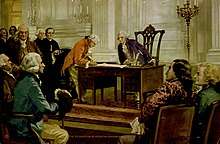
Before a quorum was reached at the Philadelphia Convention on May 25, 1787,[46] Madison worked with other members of the Virginia delegation, especially Edmund Randolph and George Mason, to create and present the Virginia Plan.[47] The Virginia Plan was an outline for a new federal constitution; it called for three branches of government (legislative, executive, and judicial), a bicameral Congress (consisting of the United States Senate and the United States House of Representatives) apportioned by population, and a federal Council of Revision that would have the right to veto laws passed by Congress. Reflecting the centralization of power envisioned by Madison, the Virginia Plan granted the U.S. Senate the power to overturn any law passed by state governments.[48] The Virginia Plan did not explicitly lay out the structure of the executive branch, but Madison himself favored a single executive.[49] Many delegates were surprised to learn that the plan called for the abrogation of the Articles and the creation of a new constitution, to be ratified by special conventions in each state rather than by the state legislatures. Nonetheless, with the assent of prominent attendees such as Washington and Benjamin Franklin, the delegates went into a secret session to consider a new constitution.[50]
Though the Virginia Plan was an outline rather than a draft of a possible constitution, and though it was extensively changed during the debate, its use at the convention has led many to call Madison the "Father of the Constitution."[51] During the course of the convention, Madison spoke over two hundred times, and his fellow delegates rated him highly. Delegate William Pierce wrote that "in the management of every great question he evidently took the lead in the Convention ... he always comes forward as the best informed man of any point in debate."[52] Madison believed that the constitution produced by the convention "would decide for ever the fate of republican government" throughout the world, and he kept copious notes to serve as an historical record of the convention.[53]
Madison had hoped that a coalition of Southern states and populous Northern states would ensure the approval of a constitution largely similar to the one proposed in the Virginia Plan. However, delegates from small states successfully argued for more power for state governments and presented the New Jersey Plan as an alternative. In response, Roger Sherman proposed the Connecticut Compromise, which sought to balance the interests of small and large states. During the course of the convention, Madison's Council of Revision was jettisoned, each state was given equal representation in the Senate, and the state legislatures, rather than the House of Representatives, were given the power to elect members of the Senate. Madison was able to convince his fellow delegates to have the Constitution ratified by ratifying conventions rather than state legislatures, which he distrusted. He also helped ensure that the president of the United States would have the ability to veto federal laws and would be elected independently of Congress through the Electoral College. By the end of the convention, Madison believed that the new constitution failed to give enough power to the federal government compared to the state governments, but he still viewed the document as an improvement on the Articles of Confederation.[54]
The ultimate question before the convention, Wood notes, was not how to design a government but whether the states should remain sovereign, whether sovereignty should be transferred to the national government, or whether the constitution should settle somewhere in between.[55] Most of the delegates at the Philadelphia Convention wanted to empower the federal government to raise revenue and protect property rights.[56] Those, like Madison, who thought democracy in the state legislatures was excessive and insufficiently "disinterested", wanted sovereignty transferred to the national government, while those who did not think this a problem, wanted to fix the Articles of Confederation. Even many delegates who shared Madison's goal of strengthening the central government reacted strongly against the extreme change to the status quo envisioned in the Virginia Plan. Though Madison lost most of his battles over how to amend the Virginia Plan, in the process he increasingly shifted the debate away from a position of pure state sovereignty. Since most disagreements over what to include in the constitution were ultimately disputes over the balance of sovereignty between the states and national government, Madison's influence was critical. Wood notes that Madison's ultimate contribution was not in designing any particular constitutional framework, but in shifting the debate toward a compromise of "shared sovereignty" between the national and state governments.[55][57]
The Federalist Papers and ratification debates
After the Philadelphia Convention ended in September 1787, Madison convinced his fellow Congressmen to remain neutral in the ratification debate and allow each state to vote upon the Constitution.[58] Throughout the United States, opponents of the Constitution, known as Anti-Federalists, began a public campaign against ratification. In response, Alexander Hamilton and John Jay began publishing a series of pro-ratification newspaper articles in New York.[59] After Jay dropped out from the project, Hamilton approached Madison, who was in New York on congressional business, to write some of the essays.[60] Altogether, Hamilton, Madison, and Jay wrote the 85 essays of what became known as The Federalist Papers in the span of six months, with Madison writing 29 of the essays. The articles were also published in book form and became a virtual debater's handbook for the supporters of the Constitution in the ratifying conventions. Historian Clinton Rossiter called The Federalist Papers "the most important work in political science that ever has been written, or is likely ever to be written, in the United States."[61] Federalist No. 10, Madison's first contribution to The Federalist Papers, became highly regarded in the 20th century for its advocacy of representative democracy.[62] In Federalist No. 51, Madison explained how the separation of powers between three branches of the federal government, as well as between state governments and the federal government, established a system of checks and balances that ensured that no one institution would become too powerful.[63]
While Madison and Hamilton continued to write The Federalist Papers, Pennsylvania, Massachusetts, and several smaller states voted to ratify the Constitution.[64] After finishing his last contributions to The Federalist Papers, Madison returned to Virginia.[65] Initially, Madison did not want to stand for election to the Virginia Ratifying Convention, but he was persuaded to do so by the strength of the Anti-Federalists.[66] Virginians were divided into three main camps: Washington and Madison led the faction in favor of ratification of the Constitution, Edmund Randolph and George Mason headed a faction that wanted ratification but also sought amendments to the Constitution, and Patrick Henry was the most prominent member of the faction opposed to the ratification of the Constitution.[67] When the Virginia Ratifying Convention began on June 2, 1788, the Constitution had been ratified by the eight of the required nine states. New York, the second largest state and a bastion of anti-federalism, would likely not ratify it without Virginia, and Virginia's exclusion from the new government would disqualify George Washington from being the first president.[66]
At the start of the convention, Madison knew that most delegates had already made up their mind about how to vote, and he focused his efforts on winning the support of the relatively small number of undecided delegates.[68] His long correspondence with Edmund Randolph paid off at the convention as Randolph announced that he would support unconditional ratification of the Constitution, with amendments to be proposed after ratification.[69] Though Henry gave several effective speeches arguing against ratification, Madison's expertise on the subject he had long argued for allowed him to respond with rational arguments to Henry's emotional appeals.[70] In his final speech to the ratifying convention, Madison implored his fellow delegates to ratify the Constitution as it had been written, arguing that the failure to do so would lead to the collapse of the entire ratification effort as each state would seek favorable amendments.[71] On June 25, 1788, the convention voted 89–79 to ratify the Constitution, making it the tenth state to do so.[72] New York ratified the constitution the following month, and Washington won the country's first presidential election.
Congressman and party leader (1789–1801)
Election to Congress
After Virginia ratified the constitution, Madison returned to New York to resume his duties in the Congress of the Confederation. At the request of Washington, Madison sought a seat in the U.S. Senate, but the state legislature instead elected two Anti-Federalist allies of Patrick Henry.[73] Now deeply concerned both for his own political career and over the possibility that Henry and his allies would arrange for a second constitutional convention, Madison ran for the U.S. House of Representatives.[74] At Henry's behest, the Virginia legislature created congressional districts designed to deny Madison a seat, and Henry recruited a strong challenger to Madison in the person of James Monroe. Locked in a difficult race against Monroe, Madison promised to support a series of constitutional amendments to protect individual liberties.[73] In an open letter, Madison wrote that, while he had opposed requiring alterations to the Constitution prior to ratification, he now believed that "amendments, if pursued with a proper moderation and in a proper mode ... may serve the double purpose of satisfying the minds of well-meaning opponents, and of providing additional guards in favor of liberty."[75] Madison's promise paid off, as he won election to Congress with 57 percent of the vote.[76]
Madison became a key adviser to President Washington, who looked to Madison as the person who best understood the constitution.[73] Madison helped Washington write his first inaugural address, and also prepared the official House response to Washington's address. He played a major role in establishing and staffing the three Cabinet departments, and his influence helped Thomas Jefferson become the inaugural Secretary of State.[77] At the start of the 1st Congress, he introduced a tariff bill similar to the one he had advocated for under the Articles of the Confederation,[78] and Congress established a federal tariff on foreign imports through the Tariff of 1789.[79] The following year, Secretary of the Treasury Alexander Hamilton introduced an ambitious economic program that called for the federal assumption of state debts and the funding of that debt through the issuance of federal securities. Hamilton's plan favored Northern speculators and was disadvantageous to states such as Virginia that had already paid off most of their debt, and Madison emerged as one of the principal congressional opponents of the plan.[80] After prolonged legislative deadlock, Madison, Jefferson, and Hamilton agreed to the Compromise of 1790, which provided for the enactment of Hamilton's assumption plan through the Funding Act of 1790. In return, Congress passed the Residence Act, which established the federal capital district of Washington, D.C. on the Potomac River.[81]
Bill of Rights
During the 1st Congress, Madison took the lead in pressing for the passage of several constitutional amendments that would form the United States Bill of Rights.[82] His primary goals were to fulfill his 1789 campaign pledge and to prevent the calling of a second constitutional convention, but he also hoped to protect individual liberties against the actions of the federal government and state legislatures. He believed that the enumeration of specific rights would fix those rights in the public mind and encourage judges to protect them.[83] After studying over two hundred amendments that had been proposed at the state ratifying conventions,[84] Madison introduced the Bill of Rights on June 8, 1789. His amendments contained numerous restrictions on the federal government and would protect, among other things, freedom of religion, freedom of speech, and the right to peaceful assembly.[85] While most of his proposed amendments were drawn from the ratifying conventions, Madison was largely responsible for proposals to guarantee freedom of the press, protect property from government seizure, and ensure jury trials.[84] He also proposed an amendment to prevent states from abridging "equal rights of conscience, or freedom of the press, or the trial by jury in criminal cases."[86]
Madison's Bill of Rights faced little opposition; he had largely co-opted the Anti-Federalist goal of amending the Constitution, but had avoided proposing amendments that would alienate supporters of the Constitution.[87] Madison's proposed amendments were largely adopted by the House of Representatives, but the Senate made several changes.[88] Madison's proposal to apply parts of the Bill of Rights to the states was eliminated, as was his final proposed change to the Constitution's preamble.[89] Madison was disappointed that the Bill of Rights did not include protections against actions by state governments,[lower-alpha 4] but passage of the document mollified some critics of the original constitution and shored up Madison's support in Virginia.[84] Of the twelve amendments formally proposed by Congress to the states, ten amendments were ratified as additions to the Constitution on December 15, 1791, becoming known as the Bill of Rights.[90][lower-alpha 5]
Founding the Democratic-Republican Party
.jpg)
After 1790, the Washington administration became polarized among two main factions. One faction was led by Jefferson and Madison, broadly represented Southern interests, and sought close relations with France. The other faction was led by Secretary of the Treasury Alexander Hamilton, broadly represented Northern financial interests, and favored close relations with Britain.[92] In 1791, Hamilton introduced a plan that called for the establishment of a national bank to provide loans to emerging industries and oversee the money supply.[93] Madison believed that, by empowering financial interests, the bank posed a threat to the republican nature of the U.S. government, and he argued that the Constitution did not grant the federal government the authority to create such an institution.[94] Despite Madison's opposition, Congress passed a bill to create the First Bank of the United States; after a period of consideration, Washington signed the banking bill into law in February 1791.[93] As Hamilton implemented his economic program and Washington continued to enjoy immense prestige as president, Madison became increasingly concerned that Hamilton would seek to abolish the federal republic in favor of a centralized monarchy.[95]
When Hamilton submitted his Report on Manufactures, which called for federal action to stimulate the development of a diversified economy, Madison once again challenged Hamilton's proposal on constitutional grounds. He sought to mobilize public opinion by forming a political party based on opposition to Hamilton's policies.[96] Along with Jefferson, Madison helped Philip Freneau establish the National Gazette, a Philadelphia newspaper that attacked Hamilton's proposals.[97] In an essay published in the National Gazette in September 1792, Madison wrote that the country had divided into two factions: his own faction, which believed in "the doctrine that mankind are capable of governing themselves," and Hamilton's faction, which allegedly sought the establishment of aristocratic monarchy and was biased towards the wealthy.[98] Those opposed to Hamilton's economic policies, including many former Anti-Federalists, coalesced into Democratic-Republican Party,[lower-alpha 6] while those who supported the administration's policies coalesced into the Federalist Party.[99] In the 1792 United States presidential election, both major parties supported Washington's successful bid for re-election, but the Democratic-Republicans sought to unseat Vice President John Adams. Because the Constitution's rules essentially precluded Jefferson from challenging Adams,[lower-alpha 7] the party backed New York Governor George Clinton for the vice presidency, but Adams won re-election by a comfortable electoral vote margin.[101]
With Jefferson out of office after 1793, Madison became the de facto leader of the Democratic-Republican Party.[102] When Britain and France went to war in 1793, the U.S. was caught in the middle.[103] While the differences between the Democratic-Republicans and the Federalists had previously centered on economic matters, foreign policy became an increasingly important issue as Madison and Jefferson favored France and Hamilton favored Britain.[104] War with Britain became imminent in 1794 after the British seized hundreds of American ships that were trading with French colonies. Madison believed that a trade war with Britain would probably succeed, and would allow Americans to assert their independence fully. The British West Indies, Madison maintained, could not live without American foodstuffs, but Americans could easily do without British manufactures.[105] Washington avoided a trade war and instead secured friendly trade relations with Britain through the Jay Treaty of 1794.[106] Madison and his Democratic-Republican allies were outraged by the treaty; one Democratic-Republican wrote that the treaty "sacrifices every essential interest and prostrates the honor of our country."[107] Madison's strong opposition to the treaty led to a permanent break with Washington, ending a long friendship.[106]
Adams presidency
Washington chose to retire after serving two terms and, in advance of the 1796 presidential election, Madison helped convince Jefferson to run for the presidency.[102] Despite Madison's efforts, Federalist candidate John Adams defeated Jefferson, taking a narrow majority of the electoral vote.[108] Under the rules of the Electoral College then in place, Jefferson became vice president because he finished with the second-most electoral votes.[109] Madison, meanwhile, had declined to seek re-election, and he returned to his home at Montpelier.[110] On Jefferson's advice, President Adams considered appointing Madison to an American delegation charged with ending French attacks on American shipping, but Adams's Cabinet members strongly opposed the idea. After a diplomatic incident between France and the United States known as the XYZ Affair took place, the two countries engaged in an undeclared naval war known as the Quasi-War.[111]
Though he was out of office, Madison remained a prominent Democratic-Republican leader in opposition to the Adams administration.[112] During the Quasi-War, the Federalists created a standing army and passed the Alien and Sedition Acts, which were directed at French refugees engaged in American politics and against Republican editors.[113] Madison and Jefferson believed that the Federalists were using the war to justify the violation of constitutional rights, and they increasingly came to view Adams as a monarchist.[114] In response to the Alien and Sedition Acts, Jefferson wrote the Kentucky Resolutions, which argued that the states had the power to nullify federal law on the basis that the Constitution was a compact among the states. Madison rejected this view of a compact among the states, and his Virginia Resolutions instead urged states to respond to unjust federal laws through interposition, a process in which a state legislature declared a law to be unconstitutional but did not take steps to actively prevent its enforcement. Jefferson's doctrine of nullification was widely rejected, and the incident damaged the Democratic-Republican Party as attention was shifted from the Alien and Sedition Acts to the unpopular nullification doctrine.[115]
In 1799, after Patrick Henry announced that he would return to politics as a member of the Federalist Party, Madison won election to the Virginia legislature. At the same time, he and Jefferson planned for Jefferson's campaign in the 1800 presidential election.[116] Madison issued the Report of 1800, which attacked the Alien and Sedition Acts as unconstitutional but disregarded Jefferson's theory of nullification. The Report of 1800 held that Congress was limited to legislating on its enumerated powers, and that punishment for sedition violated freedom of speech and freedom of the press. Jefferson embraced the report, and it became the unofficial Democratic-Republican platform for the 1800 election.[117] With the Federalists badly divided between supporters of Hamilton and Adams, and with news of the end of the Quasi-War not reaching the United States until after the election, Jefferson and his ostensible running mate, Aaron Burr, defeated Adams. Because Jefferson and Burr tied in the electoral vote, the Federalist-controlled House of Representatives held a contingent election to choose between the two candidates.[118] After the House conducted dozens of inconclusive ballots, Hamilton, who despised Burr even more than he did Jefferson, convinced several Federalist congressmen to cast blank ballots, giving Jefferson the victory.[119]
Marriage and family
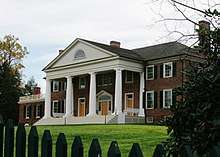
On September 15, 1794, Madison married Dolley Payne Todd, a 26-year-old widow, previously wife of John Todd, a Quaker farmer who died during a yellow fever epidemic in Philadelphia.[120] Aaron Burr introduced Madison to her, at his request, after Dolley had stayed in the same boardinghouse as Burr in Philadelphia. After an arranged meeting in spring 1794, the two quickly became romantically engaged and prepared for a wedding that summer, but Dolley suffered recurring illnesses because of her exposure to yellow fever in Philadelphia. They eventually traveled to Harewood, Virginia for their wedding. Only a few close family members attended, and Winchester Reverend Alexander Balmain pronounced them a wedded couple.[121] Madison enjoyed a strong relationship with his wife, and she became his political partner.[122] She was widely popular in the capital of Washington, and she excelled at dinners and other important political occasions.[123] Her actions helped establish the First Lady of the United States as an important social host in Washington.[124]
Madison never had children, but he adopted Dolley's one surviving son, John Payne Todd (known as Payne), after the marriage.[110] Some of Madison's colleagues, such as Monroe and Burr, alleged that Madison was infertile and that his lack of offspring weighed on his thoughts, but Madison never spoke of any distress on this matter.[125]
Throughout his life, Madison maintained a close relationship with his father, James Madison Sr, who died in 1801. At age 50, Madison inherited the large plantation of Montpelier and other possessions, including his father's numerous slaves.[126] He had three brothers, Francis, Ambrose, and William, and three sisters, Nelly, Sarah, and Frances, who lived to adulthood. Ambrose helped manage Montpelier for both his father and older brother until his death in 1793.[127]
Secretary of State (1801–1809)
Despite lacking foreign policy experience, Madison was appointed as Secretary of State by Jefferson.[128] Along with Secretary of the Treasury Albert Gallatin, Madison became one of the two major influences in Jefferson's Cabinet.[129] As the ascent of Napoleon in France had dulled Democratic-Republican enthusiasm for the French cause, Madison sought a neutral position in the ongoing Coalition Wars between France and Britain.[130] Domestically, the Jefferson administration and the Democratic-Republican Congress rolled back many Federalist policies; Congress quickly repealed the Alien and Sedition Act, abolished internal taxes, and reduced the size of the army and navy.[131] Gallatin did, however, convince Jefferson to retain the First Bank of the United States.[132] Though the Federalists were rapidly fading away at the national level, Chief Justice John Marshall ensured that Federalist ideology retained an important presence in the judiciary. In the case of Marbury v. Madison, Marshall simultaneously ruled that Madison had unjustly refused to deliver federal commissions to individuals who had been appointed to federal positions by President Adams but who had not yet taken office, but that the Supreme Court did not have jurisdiction over the case. Most importantly, Marshall's opinion established the principle of judicial review.[133]
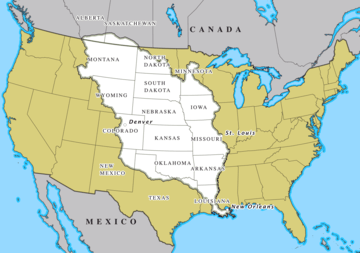
By the time Jefferson took office, Americans had settled as far west as the Mississippi River, though vast pockets of American land remained vacant or inhabited only by Native Americans. Jefferson believed that western expansion played an important role in furthering his vision of a republic of yeoman farmers, and he hoped to acquire the Spanish territory of Louisiana, which was located to the west of the Mississippi River.[134] Early in Jefferson's presidency, the administration learned that Spain planned to retrocede the Louisiana to France, raising fears of French encroachment on U.S. territory.[135] In 1802, Jefferson and Madison dispatched James Monroe to France to negotiate the purchase of New Orleans, which controlled access to the Mississippi River and thus was immensely important to the farmers of the American frontier. Rather than selling merely New Orleans, Napoleon's government, having already given up on plans to establish a new French empire in the Americas, offered to sell the entire Territory of Louisiana. Despite lacking explicit authorization from Jefferson, Monroe and ambassador Robert R. Livingston negotiated the Louisiana Purchase, in which France sold over 800,000 square miles (2,100,000 square kilometers) of land in exchange for $15 million.[136]
Despite the time-sensitive nature of negotiations with the French, Jefferson was concerned about the constitutionality of the Louisiana Purchase, and he privately favored introducing a constitutional amendment explicitly authorizing Congress to acquire new territories. Madison convinced Jefferson to refrain from proposing the amendment, and the administration ultimately submitted the Louisiana Purchase without an accompanying constitutional amendment.[137] Unlike Jefferson, Madison was not seriously concerned with the Louisiana Purchase's constitutionality. He believed that the circumstances did not warrant a strict interpretation of the Constitution because the expansion was in the country's best interest.[138] The Senate quickly ratified the treaty providing for the purchase, and the House, with equal alacrity, passed enabling legislation.[139] The Jefferson administration argued that the purchase had included the Spanish territory of West Florida, but France and Spain both held that West Florida was not included in the purchase.[140] Monroe attempted to purchase clear title to West Florida and East Florida from Spain, but the Spanish, outraged by Jefferson's claims to West Florida, refused to negotiate.[141]
Early in his tenure, Jefferson was able to maintain cordial relations with both France and Britain, but relations with Britain deteriorated after 1805.[142] The British ended their policy of tolerance towards American shipping and began seizing American goods headed for French ports.[143] They also impressed American sailors, some of whom had originally defected from the British navy, and some of whom had never been British subjects.[144] In response to the attacks, Congress passed the Non-importation Act, which restricted many, but not all, British imports.[143] Tensions with Britain heightened due to the Chesapeake–Leopard affair, a June 1807 naval confrontation between American and British naval forces, while the French also began attacking American shipping.[145] Madison believed that economic pressure could force the British to end attacks on American shipping, and he and Jefferson convinced Congress to pass the Embargo Act of 1807, which totally banned all exports to foreign nations.[146] The embargo proved ineffective, unpopular, and difficult to enforce, especially in New England.[147] In March 1809, Congress replaced the embargo with the Non-Intercourse Act, which allowed trade with nations other than Britain and France.[148]
Presidential election of 1808
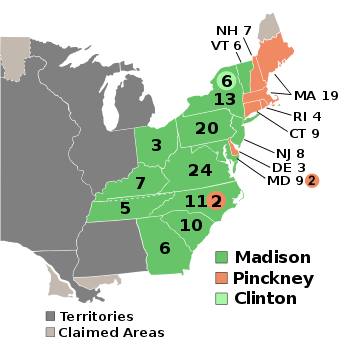
Speculation regarding Madison's potential succession of Jefferson commenced early in Jefferson's first term. Madison's status in the party was damaged by his association with the embargo, which was unpopular throughout the country and especially in the Northeast.[149] With the Federalists collapsing as a national party after 1800, the chief opposition to Madison's candidacy came from other members of the Democratic-Republican Party.[150] Madison became the target of attacks from Congressman John Randolph, a leader of a faction of the party known as the tertium quids.[151] Randolph recruited James Monroe, who had felt betrayed by the administration's rejection of the proposed Monroe–Pinkney Treaty with Britain, to challenge Madison for leadership of the party.[152] Many Northerners, meanwhile, hoped that Vice President George Clinton could unseat Madison as Jefferson's successor.[153] Despite this opposition, Madison won his party's presidential nomination at the January 1808 congressional nominating caucus.[154] The Federalist Party mustered little strength outside New England, and Madison easily defeated Federalist candidate Charles Cotesworth Pinckney.[155] At a height of only five feet, four inches (163 cm), and never weighing more than 100 pounds (45 kg), Madison became the most diminutive president.[156]
Presidency (1809–1817)
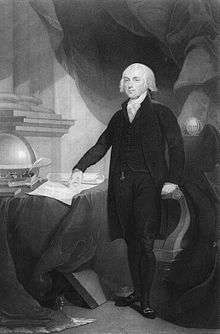
Taking office and cabinet
On March 4, 1809 Madison took the oath of office and was inaugurated President of the United States. Unlike Jefferson, who enjoyed political unity and support, Madison faced political opposition from his rival and friend, James Monroe, and by Vice President George Clinton. Additionally, the Federalist Party had resurged, under opposition to the embargo. Madison's Cabinet was very weak.[157]
Madison immediately faced opposition to his planned nomination of Secretary of the Treasury Albert Gallatin as Secretary of State. Madison chose not to fight Congress for the nomination but kept Gallatin in the Treasury Department.[158] With Gallatin's nomination declined by the Senate, Madison settled for Robert Smith, the brother of Maryland Senator Samuel Smith, to be Secretary of State.[157] For the next two years, Madison did most of the job of Secretary of State, due to Robert Smith's incompetence. After bitter party contention, Madison finally replaced Smith with Monroe in April 1811.[159][160]
The remaining members of Madison's Cabinet were chosen for the purposes of national interest and political harmony, and were largely unremarkable or incompetent.[161] With a Cabinet full of those he distrusted, Madison rarely called Cabinet meetings and instead frequently consulted with Gallatin alone.[162] Early in his presidency, Madison sought to continue Jefferson's policies of low taxes and a reduction of the national debt.[163] In 1811, Congress allowed the charter of the First Bank of the United States to lapse after Madison declined to take a strong stance on the issue.[164]
War of 1812
Prelude to war
Congress had repealed the embargo shortly before Madison became president, but troubles with the British and French continued.[165] Madison settled on a new strategy designed to pit the British and French against each other, offering to trade with whichever country would end their attacks against American shipping. The gambit almost succeeded, but negotiations with the British collapsed in mid-1809.[166] Seeking to split the Americans and British, Napoleon offered to end French attacks on American shipping so long as the United States punished any countries that did not similarly end restrictions on trade.[167] Madison accepted Napoleon's proposal in the hope that it would convince the British to finally end their policy of commercial warfare, but the British refused to change their policies, and the French reneged on their promise and continued to attack American shipping.[168]
With sanctions and other policies having failed, Madison determined that war with Britain was the only remaining option.[169] Many Americans called for a "second war of independence" to restore honor and stature to the new nation, and an angry public elected a "war hawk" Congress, led by Henry Clay and John C. Calhoun.[170] With Britain in the midst of the Napoleonic Wars, many Americans, Madison included, believed that the United States could easily capture Canada, at which point the U.S. could use Canada as a bargaining chip for all other disputes or simply retain control of it.[171] On June 1, 1812, Madison asked Congress for a declaration of war, stating that the United States could no longer tolerate Britain's "state of war against the United States." The declaration of war was passed along sectional and party lines, with opposition to the declaration coming from Federalists and from some Democratic-Republicans in the Northeast.[172] In the years prior to the war, Jefferson and Madison had reduced the size of the military, leaving the country with a military force consisting mostly of poorly trained militia members.[173] Madison asked Congress to quickly put the country "into an armor and an attitude demanded by the crisis," specifically recommending expansion of the army and navy.[174]
Military action
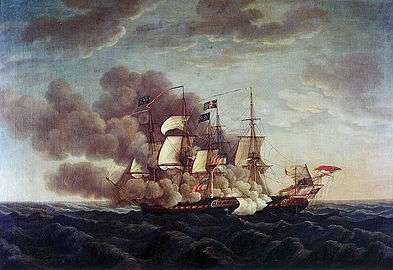
Madison and his advisers initially believed the war would be a quick American victory, while the British were occupied fighting in the Napoleonic Wars.[171][175] Madison ordered an invasion of Canada at Detroit, designed to defeat British control around American held Fort Niagara and destroy the British supply lines from Montreal. These actions would give leverage for British concessions on the Atlantic high seas.[175] Madison believed state militias would rally to the flag and invade Canada, but the governors in the Northeast failed to cooperate, and the militias either sat out the war or refused to leave their respective states.[176] As a result, Madison's first Canadian campaign ended in dismal failure. On August 16, Major General William Hull surrendered to British and Native American forces at Detroit.[175] On October 13, a separate U.S. force was defeated at Queenton Heights.[177][175] Commanding General Henry Dearborn, hampered by mutinous New England infantry, retreated to winter quarters near Albany, after failing to destroy Montreal's vulnerable British supply lines.[175]
Lacking adequate revenue to fund the war, the Madison administration was forced to rely on high-interest loans furnished by bankers based in New York City and Philadelphia.[178] In the 1812 presidential election, held during the early stages of the War of 1812, Madison faced a challenge from DeWitt Clinton, who led a coalition of Federalists and disaffected Democratic-Republicans. Clinton won most of the Northeast, but Madison won the election by sweeping the South and the West and winning the key state of Pennsylvania.[179]
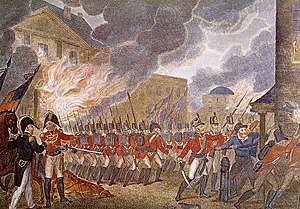
After the disastrous start to the War of 1812, Madison accepted Russia's invitation to arbitrate the war, and he sent a delegation led by Gallatin and John Quincy Adams to Europe to negotiate a peace treaty.[171] While Madison worked to end the war, the U.S. experienced some impressive naval successes, boosting American morale, by the USS Constitution, and other warships.[180][175] With a victory at the Battle of Lake Erie, the U.S. crippled the supply and reinforcement of British military forces in the western theater of the war.[181] In the aftermath of the Battle of Lake Erie, General William Henry Harrison defeated the forces of the British and of Tecumseh's Confederacy at the Battle of the Thames. The death of Tecumseh in that battle marked the permanent end of armed Native American resistance in the Old Northwest.[182] In March 1814, General Andrew Jackson broke the resistance of the British-allied Muscogee in the Old Southwest with his victory at the Battle of Horseshoe Bend.[183] Despite those successes, the British continued to repel American attempts to invade Canada, and a British force captured Fort Niagara and burned the American city of Buffalo in late 1813.[184]
The British agreed to begin peace negotiations in the town of Ghent in early 1814, but at the same time, they shifted soldiers to North America following Napoleon's defeat in the Battle of Paris.[185] Under General George Izard and General Jacob Brown, the U.S. launched another invasion of Canada in mid-1814. Despite an American victory at the Battle of Chippawa, the invasion stalled once again.[186]
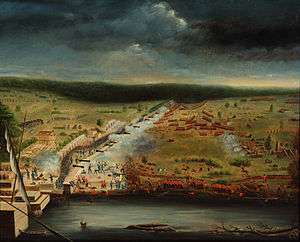
Making matters worse, Madison had failed to muster his new Secretary of War John Armstrong to fortify Washington D.C., while Madison had put in command, to stop an impending British invasion, an "inexperienced and incompetent" Brig. General William Winder.[187] In August 1814, the British landed a large force off the Chesapeake Bay and routed Winder's army at the Battle of Bladensburg.[188] The Madisons escaped capture, fleeing to Virginia by horseback, in the aftermath of the battle, but the British burned Washington and other buildings.[189][190] The charred remains of the capital by the British were a humiliating defeat for Madison and America.[187] The British army next moved on Baltimore, but the U.S. repelled the British attack in the Battle of Baltimore, and the British army departed from the Chesapeake region in September.[191] That same month, U.S. forces repelled a British invasion from Canada with a victory at the Battle of Plattsburgh.[192] The British public began to turn against the war in North America, and British leaders began to look for a quick exit from the conflict.[193]
In January 1815, an American force under General Jackson defeated the British at the Battle of New Orleans.[194] Just over a month later, Madison learned that his negotiators had reached the Treaty of Ghent, ending the war without major concessions by either side. Madison quickly sent the Treaty of Ghent to the Senate, and the Senate ratified the treaty on February 16, 1815.[195] To most Americans, the quick succession of events at the end of the war, including the burning of the capital, the Battle of New Orleans, and the Treaty of Ghent, appeared as though American valor at New Orleans had forced the British to surrender. This view, while inaccurate, strongly contributed to a feeling of post-war euphoria that bolstered Madison's reputation as president.[196] Napoleon's defeat at the June 1815 Battle of Waterloo brought a final close to the Napoleonic Wars, ending the danger of attacks on American shipping by British and French forces.[197]
Postwar period
The postwar period of Madison's second term saw the transition into the "Era of Good Feelings," as the Federalists ceased to act as an effective opposition party.[198] During the war, delegates from the states of New England held the Hartford Convention, where the delegates asked for several amendments to the Constitution.[199] Though the Hartford Convention did not explicitly call for the secession of New England,[200] the Hartford Convention became a political millstone around the Federalist Party as Americans celebrated what they saw as a successful "second war of independence" from Britain.[201] Madison hastened the decline of the Federalists by adopting several programs he had previously opposed, weakening the ideological divisions between the two major parties.[202]
Recognizing the difficulties of financing the war and the necessity of an institution to regulate the currency, Madison proposed the re-establishment of a national bank. He also called for increased spending on the army and the navy, a tariff designed to protect American goods from foreign competition, and a constitutional amendment authorizing the federal government to fund the construction of internal improvements such as roads and canals. His initiatives were opposed by strict constructionists such as John Randolph, who stated that Madison's proposals "out-Hamiltons Alexander Hamilton."[203] Responding to Madison's proposals, the 14th Congress compiled one of the most productive legislative records up to that point in history.[204] Congress granted the Second Bank of the United States a twenty-five-year charter[203] and passed the Tariff of 1816, which set high import duties for all goods that were produced in the United States.[204] Madison approved federal spending on the Cumberland Road, which provided a link to the country's western lands,[205] but in his last act before leaving office, he blocked further federal spending on internal improvements by vetoing the Bonus Bill of 1817. In making the veto, Madison argued that the General Welfare Clause did not broadly authorize federal spending on internal improvements.[206]
Native American policy
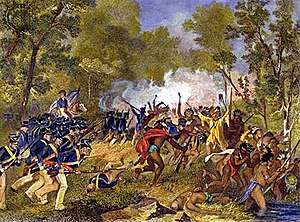
November 7, 1811
Upon becoming president, Madison said the federal government's duty was to convert the American Indians by the "participation of the improvements of which the human mind and manners are susceptible in a civilized state".[163] Within six months of his first term of office, on September 30, 1809, Madison, by Indiana Territory Governor William Henry Harrison, agreed to the Treaty of Fort Wayne. The treaty began with "James Madison, President of the United States," on the first sentence of the first paragraph.[207] The American Indian tribes were compensated $5,200 ($109,121.79 for year 2020) in goods and $500 and $250 annual subsidies to the various tribes, for 3 million acres of land.[208] The treaty angered Shawnee leader Tecumseh, who said, "Sell a country! Why not sell the air, the clouds and the great sea, as well as the earth?"[209] William Henry Harrison, governor of the Indiana Territory, responded that the Miami tribe was the owner of the land and could sell to whom the Miami tribe wished.[210]
Like Jefferson, Madison had a paternalistic attitude toward American Indians, encouraging the men to give up hunting and become farmers.[211] Madison believed the adoption of European-style agriculture would help Native Americans assimilate the values of British-U.S. civilization. As pioneers and settlers moved West into large tracts of Cherokee, Choctaw, Creek, and Chickasaw territory, Madison ordered the U.S. Army to protect Native lands from intrusion by settlers, to the chagrin of his military commander Andrew Jackson, who wanted Madison to ignore Indian pleas to stop the invasion of their lands.[212] Tensions mounted between the United States and Temcuseh over the 1809 Treaty of Fort Wayne, that ultimately led to Tecumseh's alliance with the British and the Battle of Tippecanoe, on November 7, 1811, in the Northwest Territory.[212][213] Tecumseh was defeated and Indians were pushed off their tribal lands, replaced entirely by white settlers.[212] [213]
In addition to the Battle of the Thames and the Battle of Horseshoe Bend, other American Indian battles took place, including the Peoria War, and the Creek War. Settled by General Jackson, the Creek War added 20 million acres of land to the United States, in Georgia and Alabama, by the Treaty of Fort Jackson on August 9, 1814.[214]
Privately, Madison did not believe American Indians could be civilized. Madison believed that American Indians were unwilling to "transition from the hunter, or even the herdsman state, to the agriculture."[209] Madison viewed that American Indians were in a "savage state", characterized by "complete liberty", absent of any cohesive bonds, obligations, or public duties. [209] Madison believed settlers who comingled with American Indians were attracted to the American Indian lifestyle. In March 1816, Madison's Secretary of War William Crawford advocated that Congress encourage intermarriages between American Indians and whites. This prompted public outrage, including hostile letters sent to Madison, who remained publicly silent. During Madison's presidency, white Americans became more hostile to American Indians.[209]
General Wilkinson misconduct

Peale 1797
In 1810, the House investigated Commanding General James Wilkinson for misconduct over his ties with Spain.[215] Wilkinson was a hold-over of the Jefferson Administration, who at that time in 1806, Jefferson was told Wilkinson was under a financial retainer with Spain. Wilkinson had also been rumored to have been tied with Spain during both the Washington and Adams administrations. Jefferson removed Wilkinson from his position of Governor of the Louisiana territory in 1807, for his ties with the Burr conspiracy. [216] The 1810 House investigation was not a formal report but documents incriminating Wilkinson were given to Madison. Wilkinson's military request for a court-martial was denied by Madison. Wilkinson then asked for 14 officers to testify on his behalf, in Washington, but Madison refused, in essence, clearing Wilkinson of malfeasance.[215]
Later in 1810 the House investigated Wilkinson's public record, and charged him with a high casualty rate among soldiers. Wilkinson was cleared again. However, in 1811, Madison launched a formal court-martial of Wilkinson, that suspended Wilkinson of active duty. The military court in December 1811, cleared Wilkinson of misconduct. Madison approved of the Wilkinson's acquittal, and restored Wilkinson to active duty. [215] After Wilkinson failed a command during the War of 1812, Madison dismissed Wilkinson from command of the Army for incompetence. Madison, however, retained Wilkinson in the Army, but replaced Wilkinson with Henry Dearborn, as Commander of the Army. Not until 1815, when Wilkinson was court-martialled and acquitted again, did Madison finally remove him from the Army.[215] Historical evidence brought forth later in the Twentieth Century proved Wilkinson was under the pay of Spain. [217]
Election of 1816
In the 1816 presidential election, Madison and Jefferson both favored the candidacy of Secretary of State James Monroe. With the support of Madison and Jefferson, Monroe defeated Secretary of War William H. Crawford in the party's congressional nominating caucus. As the Federalist Party continued to collapse as a national party, Monroe easily defeated Federalist candidate Rufus King in the 1816 election.[218] Madison left office as a popular president; former president Adams wrote that Madison had "acquired more glory, and established more union, than all his three predecessors, Washington, Adams, and Jefferson, put together."[219]
Retirement, national leader, and elder statesman
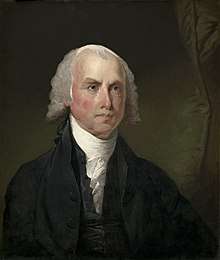
When Madison left office in 1817 at age 65, he retired to Montpelier, his tobacco plantation in Orange County, Virginia, not far from Jefferson's Monticello. As with both Washington and Jefferson, Madison left the presidency a poorer man than when elected. His plantation experienced a steady financial collapse, due to the continued price declines in tobacco and also due to his stepson's mismanagement.[220]
In his retirement, Madison occasionally became involved in public affairs, advising Andrew Jackson and other presidents.[221] He remained out of the public debate over the Missouri Compromise, though he privately complained about the North's opposition to the extension of slavery.[222] Madison had warm relations with all four of the major candidates in the 1824 presidential election, but, like Jefferson, largely stayed out of the race.[223] During Jackson's presidency, Madison publicly disavowed the Nullification movement and argued that no state had the right to secede.[224]
Madison helped Jefferson establish the University of Virginia, though the university was primarily Jefferson's initiative.[225] In 1826, after the death of Jefferson, Madison was appointed as the second rector of the university. He retained the position as college chancellor for ten years until his death in 1836.

In 1829, at the age of 78, Madison was chosen as a representative to the Virginia Constitutional Convention for revision of the commonwealth's constitution. It was his last appearance as a statesman. The issue of greatest importance at this convention was apportionment. The western districts of Virginia complained that they were underrepresented because the state constitution apportioned voting districts by county. The increased population in the Piedmont and western parts of the state were not proportionately represented by delegates in the legislature. Western reformers also wanted to extend suffrage to all white men, in place of the prevailing property ownership requirement. Madison tried in vain to effect a compromise. Eventually, suffrage rights were extended to renters as well as landowners, but the eastern planters refused to adopt citizen population apportionment. They added slaves held as property to the population count, to maintain a permanent majority in both houses of the legislature, arguing that there must be a balance between population and property represented. Madison was disappointed at the failure of Virginians to resolve the issue more equitably.[226]
In his later years, Madison became highly concerned about his historic legacy. He resorted to modifying letters and other documents in his possession, changing days and dates, adding and deleting words and sentences, and shifting characters. By the time he had reached his late seventies, this "straightening out" had become almost an obsession. As an example, he edited a letter written to Jefferson criticizing Lafayette—Madison not only inked out original passages, but even forged Jefferson's handwriting as well.[227] Historian Drew R. McCoy writes that, "During the final six years of his life, amid a sea of personal [financial] troubles that were threatening to engulf him ... At times mental agitation issued in physical collapse. For the better part of a year in 1831 and 1832 he was bedridden, if not silenced ... Literally sick with anxiety, he began to despair of his ability to make himself understood by his fellow citizens."[228]
Madison's health slowly deteriorated. He died of congestive heart failure at Montpelier on the morning of June 28, 1836, at the age of 85.[229] By one common account of his final moments, he was given his breakfast, which he tried eating but was unable to swallow. His favorite niece, who sat by to keep him company, asked him, "What is the matter, Uncle James?" Madison died immediately after he replied, "Nothing more than a change of mind, my dear."[230] He is buried in the family cemetery at Montpelier.[220] He was one of the last prominent members of the Revolutionary War generation to die.[221] His will left significant sums to the American Colonization Society, the University of Virginia, and the College of New Jersey, as well as $30,000 to his wife, Dolley. Left with a smaller sum than Madison had intended, Dolley suffered financial troubles until her own death in 1849.[231]
Political and religious views
Federalism
| External video | |
|---|---|
During his first stint in Congress in the 1780s, Madison came to favor amending the Articles of Confederation to provide for a stronger central government.[232] In the 1790s, he led the opposition to Hamilton's centralizing policies and the Alien and Sedition Acts.[233] According to Chernow, Madison's support of the Virginia and Kentucky Resolutions in the 1790s "was a breathtaking evolution for a man who had pleaded at the Constitutional Convention that the federal government should possess a veto over state laws."[113] The historian Gordon S. Wood says that Lance Banning, as in his Sacred Fire of Liberty (1995), is the "only present-day scholar to maintain that Madison did not change his views in the 1790s."[234] During and after the War of 1812, Madison came to support several policies he had opposed in the 1790s, including the national bank, a strong navy, and direct taxes.[235]
Wood notes that many historians struggle to understand Madison, but Wood looks at him in the terms of Madison's own times—as a nationalist but one with a different conception of nationalism from that of the Federalists.[234] Gary Rosen and Banning use other approaches to suggest Madison's consistency.[236][237][238]
Religion
Although baptized as an Anglican and educated by Presbyterian clergymen,[239] young Madison was an avid reader of English deist tracts.[240] As an adult, Madison paid little attention to religious matters. Though most historians have found little indication of his religious leanings after he left college,[241] some scholars indicate he leaned toward deism.[242][243] Others maintain that Madison accepted Christian tenets and formed his outlook on life with a Christian world view.[244]
Regardless of his own religious beliefs, Madison believed in religious liberty, and he advocated for Virginia's disestablishment of the Anglican Church throughout the late 1770s and 1780s.[245] He also opposed the appointments of chaplains for Congress and the armed forces, arguing that the appointments produce religious exclusion as well as political disharmony.[246] In 1819, Madison said, "The number, the industry, and the morality of the priesthood & the devotion of the people have been manifestly increased by the total separation of the Church from the State."[247]
Slavery
Madison grew up on a plantation that made use of slave labor and he viewed the institution as a necessary part of the Southern economy, though he was troubled by the instability of a society that depended on a large enslaved population.[248] At the Philadelphia Convention, Madison favored an immediate end to the importation of slaves, though the final document barred Congress from interfering with the international slave trade until 1808,[249] while the domestic trade in slaves was expressly permitted by the constitution.[250] He also proposed that apportionment in the United States Senate be allocated by the sum of each state's free population and slave population, eventually leading to the adoption of the Three-Fifths Compromise.[251] Madison supported the extension of slavery into the West during the Missouri crisis of 1819–1821.[250] Madison believed that former slaves were unlikely to successfully integrate into Southern society, and in the late 1780s, he became interested in the idea of African-Americans establishing colonies in Africa.[252] Madison was president of the American Colonization Society, which founded the settlement of Liberia for former slaves.[253]
Madison was unable to separate himself from the institution of domestic slavery. Although Madison had championed a Republican form of government, he believed that slavery had caused the South to become aristocratic. Madison believed that slaves were human property, while he opposed slavery intellectually.[254] Along with his colonization plan for blacks, Madison believed that slavery would naturally diffuse with western expansion. Madison's political views landed somewhere between John C. Calhoun's separation nullification and Daniel Webster's nationalism consolidation. Madison's Virginian "legatees" including Edward Coles, Nicolas P. Trist, and William Cabel Rives promoted Madison's moderate views on slavery into the 1840s and 1850s, but their campaign failed due to sectionalism, economic, and abolitionism forces.[254] Madison was never able to reconcile his advocacy of Republican government and his lifelong reliance on the slave system.[1]
Madison's treatment of his enslaved people was known to be moderate. In 1790, Madison ordered an overseer to treat slaves with "all the humanity and kindness of consistent with their necessary subordination and work." Visitors noted slaves were well housed and fed. According to Paul Jennings, one of Madison's younger slaves, Madison never lost his temper or had his slaves whipped, preferring to reprimand.[255] One slave, Billey, attempted to escape Madison while in Philadelphia during the American Revolution, but was caught. Rather than free him, or return him to Virginia, Madison sold Billey in Philadelphia, under a gradual emancipation law adopted in Pennsylvania. Billey soon earned his freedom and worked for a Philadelphia merchant. Billey, however, was drowned on a voyage to New Orleans.[255] Madison never outwardly expressed the view that blacks were inferior; he tended to express open-mindedness on the question of race.[256]
By 1801, Madison's slave population at Montpelier was slightly over 100. During the 1820s and 1830s, Madison was forced to sell land and slaves, caused by debts. In 1836, at the time of Madison's death, Madison owned 36 taxable slaves.[256] Madison's conservatism prevailed, due to finances, while he failed to free any of his slaves either during his lifetime or in his will.[250][254] Upon Madison's death, he left his remaining slaves to his wife Dolley, asking her only to sell her slaves with their consent. However, Dolley, sold many of her slaves without their consent. The remaining slaves, after Dolley's death, were given to her son, Payne Todd, who freed them upon his death. However, Todd had debts, and likely only a few slaves were actually freed. [257]
Physical characteristics and health
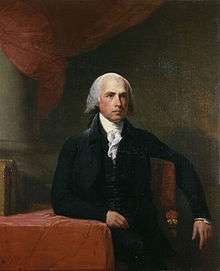
Gilbert Stuart 1805–1807
Madison was small in stature, had bright blue eyes, a strong demeanor, and was known to be humorous at small gatherings. Madison suffered from serious illnesses, nervousness, and was often exhausted after periods of stress. Madison often feared for the worst and was a hypochondriac. However, Madison was in good health, while he lived a long life, without the common maladies of his times.[258]
Legacy
Historical reputation
Madison is widely regarded as one of the most important Founding Fathers of the United States. Historian J.C.A. Stagg writes that "in some ways—because he was on the winning side of every important issue facing the young nation from 1776 to 1816—Madison was the most successful and possibly the most influential of all the Founding Fathers."[259] Though he helped found a major political party and served as the fourth president of the United States, his legacy has largely been defined by his contributions to the Constitution; even in his own life he was hailed as the "Father of the Constitution."[260] Law professor Noah Feldman writes that Madison "invented and theorized the modern ideal of an expanded, federal constitution that combines local self-government with an overarching national order." Feldman adds that Madison's "model of liberty-protecting constitutional government" is "the most influential American idea in global political history."[261]
Polls of historians and political scientists tend to rank Madison as an above average president. A 2018 poll of the American Political Science Association's Presidents and Executive Politics section ranked Madison as the twelfth best president.[262] Wood commends Madison for his steady leadership during the war and resolve to avoid expanding the president's power, noting one contemporary's observation that the war was conducted "without one trial for treason, or even one prosecution for libel."[263] Nonetheless, many historians have criticized Madison's tenure as president.[264] Henry Steele Commager and Richard B. Morris in 1968 said the conventional view of Madison was as an "incapable President" who "mismanaged an unnecessary war."[265] A 2006 poll of historians ranked Madison's failure to prevent the War of 1812 as the sixth-worst mistake made by a sitting president.[266]
The historian Garry Wills wrote, "Madison's claim on our admiration does not rest on a perfect consistency, any more than it rests on his presidency. He has other virtues. ... As a framer and defender of the Constitution he had no peer. ... The finest part of Madison's performance as president was his concern for the preserving of the Constitution. ... No man could do everything for the country—not even Washington. Madison did more than most, and did some things better than any. That was quite enough."[267]
In 2002, historian Ralph Ketcham was critical of Madison as a wartime President during the War of 1812. Ketchum blamed Madison for the events that led up to the burning of the nation's capital by the British.[268] Ketchum said: "The events of the summer of 1814 illustrate all too well the inadequacy in wartime of Madison's habitual caution and tendency to let complexities remain unresolved...Although such inclinations are ordinarily virtues, in crisis they are calamitous."[269] Ketchum said "it was, ironically, Madison's very republican virtue that in part unsuited him to be a wartime president."[270]
In 1974, historian James Banner criticized Madison for his protection of a corrupt General James Wilkinson in the Army. Wilkinson had been involved in the Aaron Burr Conspiracy during the Jefferson Administration, was on retainer of Spain, and had a high mortality rate among soldiers. Wilkinson had also botched a campaign during the War of 1812. Madison finally mustered Wilkinson out of the Army in 1815.[271]
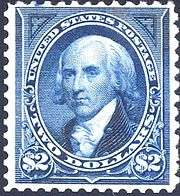 1894 postage stamp honoring Madison |
 2007 Presidential Dollar of James Madison |
 Madison appears on various U.S. Revenue stamps |
Memorials
Montpelier, his family's plantation, has been designated a National Historic Landmark. The James Madison Memorial Building is a building of the United States Library of Congress and serves as the official memorial to Madison. In 1986, Congress created the James Madison Memorial Fellowship Foundation as part of the bicentennial celebration of the Constitution. Several counties and communities have been named for Madison, including Madison County, Alabama and Madison, Wisconsin. Other things named for Madison include Madison Square, James Madison University, and the USS James Madison.
See also
- Irving Newton Brant, Madison's leading biographer
- List of delegates to the Continental Congress
- List of Presidents of the United States
- Republicanism
Notes
- Vice President Clinton and Vice President Gerry both died in office. Neither was replaced for the remainder of their respective terms, as the Constitution did not have a provision for filling a vice presidential vacancy prior to the adoption of the Twenty-Fifth Amendment in 1967.
- (O.S. March 5, 1750)
- After the ratification of the Articles of Confederation in 1781, the Second Continental Congress became the Congress of the Confederation.[24]
- Portions of the Bill of Rights would later be incorporated against the states.
- One of the two unratified amendments became part of the Constitution in 1992 as the Twenty-seventh Amendment. The other unratified amendment, known as the Congressional Apportionment Amendment, is technically still pending before the states.[91]
- The Democratic-Republican Party was often referred to as the "Republican Party." It was a separate entity from the later Republican Party, which was founded in the 1850s.
- Because the Constitution requires presidential electors to vote for at least one individual from outside their home state, electors from Virginia would not have been able to vote for both Washington and Jefferson.[100]
References
- Ketcham 2002, p. 57.
- Ketcham 1990, p. 12
- "The Life of James Madison". James Madison's Montpelier. Retrieved October 21, 2017.
- Ketcham 1990, p. 5.
- Boyd-Rush, Dorothy. "Molding a founding father". Montpelier. Retrieved March 25, 2013.
- "The Life of James Madison". The Montpelier Foundation. Retrieved February 14, 2017.
- Feldman 2017, pp. 3–7
- Feldman 2017, pp. 5–6
- Ketcham, Ralph (2003). James Madison: A Biography. Newtown, CT: American Political Biography Press. p. 35.
- Ketcham, Ralph (2003). James Madison: A Biography. Newtown, CT: American Political Biography Press. p. 34.
- Feldman 2017, pp. 4–5
- Ketcham 1990, p. 51.
- Ball, Terence (2017). James Madison. Taylor & Francis. pp. 45–46.
- Feldman 2017, pp. 7–8
- Mary Sarah Bilder. "James Madison, Law Student and Demi-Lawyer." Law and History Review 28#2 (2010): 389–449 online.
- Feldman 2017, pp. 17–18
- Feldman 2017, pp. 10–14
- Stagg, J.A., ed. (October 4, 2016). "James Madison: Life Before the Presidency". Univ. of Virginia Miller Center. Retrieved February 14, 2017.
- Wills 2002, pp. 12–13
- Burstein & Isenberg 2010, pp. 14–15
- Feldman 2017, pp. 25–27
- Burstein & Isenberg 2010, pp. 48–49, 59–60
- Burstein & Isenberg 2010, pp. 65–66
- Ferling 2003, pp. 230–232
- Burstein & Isenberg 2010, pp. 96–97
- Burstein & Isenberg 2010, pp. 96–98
- Ketcham, Ralph (2003). James Madison: A Biography. Newtown, CT: American Political Biography Press. pp. 120–123.
- Burstein & Isenberg 2010, p. xxiv
- Wills 2002, pp. 17–19.
- Feldman 2017, p. 70
- Burstein & Isenberg 2010, pp. 96–97, 128–130
- Wood 2011, p. 104
- Burstein & Isenberg 2010, pp. 129–130
- Rutland 1987, p. 14.
- Burstein & Isenberg 2010, pp. 136–137
- Feldman 2017, pp. 56–57, 74–75
- Feldman 2017, pp. 98–99, 121–122
- Ketcham, Ralph (2003). James Madison: A Biography. Newtown, CT: American Political Biography Press. pp. 177–179.
- Burstein & Isenberg 2010, pp. 137–138
- Feldman 2017, pp. 78–79
- Wills 2002, pp. 24–26.
- Feldman 2017, p. 87
- Burstein & Isenberg 2010, pp. 138–139, 144
- Feldman 2017, pp. 82–83
- Robinson, Raymond H. "The Marketing of an Icon". George Washington: American Symbol. p. 117.
Figure 56 John Henry Hintermeister (American 1869–1945) Signing of the Constitution, 1925...Alternatively labeled Title to Freedom and the Foundation of American Government...".
- Feldman 2017, p. 107
- Burstein & Isenberg 2010, pp. 150–151
- Burstein & Isenberg 2010, pp. 140–141
- Feldman 2017, pp. 115–117
- Wills 2002, pp. 25–27.
- Stewart 2007, p. 181.
- Rutland 1987, p. 18.
- Feldman 2017, pp. 107–108
- Burstein & Isenberg 2010, pp. 152–166, 171
- Wood 2011, p. 183.
- Burstein & Isenberg 2010, pp. 148–149
- Stewart 2007, p. 182.
- Burstein & Isenberg 2010, pp. 164–166
- Feldman 2017, pp. 177–178
- Feldman 2017, pp. 179–180
- Rossiter, Clinton, ed. (1961). The Federalist Papers. Penguin Putnam, Inc. pp. ix, xiii.
- Wills 2002, pp. 31–35.
- Feldman 2017, pp. 208–209
- Feldman 2017, pp. 195–196, 213
- Feldman 2017, pp. 215–216
- Labunski 2006, p. 82.
- Feldman 2017, pp. 191–192
- Burstein & Isenberg 2010, pp. 179–180
- Feldman 2017, pp. 231–233
- Wills 2002, pp. 35–37.
- Feldman 2017, pp. 239–240
- Burstein & Isenberg 2010, pp. 182–183
- Wills 2002, pp. 38–39.
- Feldman 2017, pp. 247–248, 251–252
- Feldman 2017, pp. 252–253
- Labunski 2006, pp. 148–50.
- Burstein & Isenberg 2010, pp. 189–193, 203
- Feldman 2017, pp. 258–259
- Bordewich 2016, pp. 100–102
- Burstein & Isenberg 2010, pp. 213–217
- Burstein & Isenberg 2010, pp. 217–220
- Burstein & Isenberg 2010, pp. 195–197
- Feldman 2017, pp. 264, 267, 272–274
- Burstein & Isenberg 2010, pp. 197–199
- Feldman 2017, pp. 267–269
- Feldman 2017, pp. 270–271
- Feldman 2017, pp. 274–275
- Feldman 2017, pp. 275–276
- Labunski 2006, p. 232.
- "The Charters of Freedom: The Bill of Rights". National Archives and Records Administration. October 31, 2015. Retrieved February 16, 2017.
- Thomas, Kenneth R., ed. (2013). "The Constitution of the United States of America: Analysis of Cases Decided by the Supreme Court of the U.S." (PDF). GPO. p. 49. Retrieved February 16, 2017.
- Burstein & Isenberg 2010, pp. 207–208
- Burstein & Isenberg 2010, pp. 221–224
- Feldman 2017, pp. 316–322, 331
- Feldman 2017, p. 343
- Feldman 2017, pp. 343–347
- Feldman 2017, pp. 324–326
- Feldman 2017, pp. 366–367
- Burstein & Isenberg 2010, pp. 279–280
- Feldman 2017, p. 369
- Feldman 2017, pp. 369–370
- Burstein & Isenberg 2010, pp. 305–306
- Burstein & Isenberg 2010, pp. 261–262
- Feldman 2017, pp. 373–374
- Varg, Paul A. (1963). Foreign Policies of the Founding Fathers. Michigan State Univ. Press. p. 74.
- Wills 2002, pp. 38–44.
- Feldman 2017, pp. 396–398
- Burstein & Isenberg 2010, pp. 317–318
- Feldman 2017, pp. 408–400
- Burstein & Isenberg 2010, pp. 321–322
- Feldman 2017, pp. 411–414
- Wills 2002, pp. 48–49.
- Chernow, Ron. (2004). Alexander Hamilton. Penguin. pp. 571–74. ISBN 9780143034759. Retrieved February 16, 2017.
- Feldman 2017, pp. 415–417
- Feldman 2017, pp. 417–421
- Feldman 2017, pp. 424–425
- Feldman 2017, pp. 428–430
- Feldman 2017, pp. 433–436
- Feldman 2017, pp. 438–439
- Ketcham 1990, p. 377.
- Ketcham, Ralph (2003). James Madison: A Biography. Newtown, CT: American Political Biography Press. pp. 376–383.
- Feldman 2017, pp. 479–480
- Feldman 2017, pp. 445–447
- Feldman 2017, pp. 506–507
- Ketcham, Ralph (2003). James Madison: A Biography. Newtown, CT: American Political Biography Press. p. 387.
- Feldman 2017, pp. 443–444
- Ketcham, Ralph (2003). James Madison: A Biography. Newtown, CT: American Political Biography Press. pp. 370–371.
- Wills 2002, pp. 50–51.
- McDonald 1976, pp. 36–38
- Burstein & Isenberg 2010, pp. 373–374
- McDonald 1976, pp. 42–44
- Wood 2009, pp. 293–296
- Feldman 2017, pp. 465–466
- Wood 2009, pp. 357–359, 366–367
- Burstein & Isenberg 2010, pp. 374–376
- Burstein & Isenberg 2010, pp. 382–389
- Feldman 2017, pp. 463–465
- Ketcham, Ralph (2003). James Madison: A Biography. Newtown, CT: American Political Biography Press. p. 422.
- Ketcham 1990, pp. 419–21
- Wills 2002, pp. 51–52.
- Feldman 2017, pp. 462–463
- McDonald 1976, pp. 100–101
- Wood 2009, pp. 640–642
- Wills 2002, pp. 81–84.
- Wood 2009, pp. 644–649
- Feldman 2017, pp. 493–495
- Feldman 2017, pp. 494–495
- Wood 2009, pp. 652–657
- Burstein & Isenberg 2010, pp. 457–458
- Burstein & Isenberg 2010, pp. 438–439
- Burstein & Isenberg 2010, pp. 434–435
- Feldman 2017, pp. 496–497
- Burstein & Isenberg 2010, pp. 457–459
- Feldman 2017, p. 498
- Rutland 1990, p. 5.
- McCullough, Noah (2006). The Essential Book of Presidential Trivia. Random House Digital, Inc. p. 21. ISBN 9781400064823. Retrieved February 14, 2017.
- Ketcham 2002, pp. 61–62.
- Rutland 1990, pp. 32–33.
- Ketcham 2002, p. 62.
- Feldman 2017, pp. 524–527
- Rutland 1990, pp. 32–33, 51, 55.
- Wills 2002, pp. 64–65.
- Rutland 1990, p. 20.
- Rutland 1990, p. 68–70.
- Rutland 1990, p. 13.
- Feldman 2017, pp. 508–512
- Rutland 1990, pp. 62–64.
- Rutland 1990, pp. 64–66, 81.
- Feldman 2017, pp. 532–537
- Risjord, Norman K. (1961). "1812: Conservatives, War Hawks and the Nation's Honor". The William and Mary Quarterly. 18 (2): 196–210. doi:10.2307/1918543. JSTOR 1918543.
- Wills 2002, pp. 97–98.
- Feldman 2017, pp. 543–545
- Rutland 1990, p. 159.
- Ketcham (1971), James Madison, pp. 509–15
- Ketcham 2002, p. 65.
- Feldman 2017, pp. 551–552
- Feldman 2017, pp. 548–550
- Rutland 1990, pp. 126–127.
- Feldman 2017, pp. 555–557
- Feldman 2017, pp. 554, 566–567
- Roosevelt, Theodore, The Naval War of 1812, pp. 147–52, The Modern Library, New York, NY.
- Rutland 1990, p. 133.
- Rutland 1990, pp. 138–139, 150.
- Feldman 2017, pp. 569–571
- Rutland 1990, pp. 150–153.
- Rutland 1990, pp. 152–153.
- Ketcham 2002, pp. 66–67.
- Feldman 2017, pp. 579–585
- Feldman 2017, pp. 586–588
- Ketcham 2002, p. 67.
- Rutland 1990, pp. 165–167.
- Wills 2002, pp. 130–131.
- Rutland 1990, pp. 179–180.
- Rutland 1990, p. 185.
- Rutland 1990, pp. 186–188.
- Rutland 1987, p. 188.
- Rutland 1990, pp. 192–201.
- Burstein & Isenberg 2010, pp. 547–548
- Wills 2002, pp. 145–146, 150.
- Feldman 2017, pp. 599–600
- Rutland 1990, pp. 211–212.
- Burstein & Isenberg 2010, pp. 559–560
- Rutland 1990, pp. 195–198.
- Howe 2007, pp. 82–84.
- Rutland 1990, pp. 198–199.
- Rutland 1990, pp. 204–207.
- Kappler 1904, pp. 101–102.
- Owens 2007, pp. 201–203; Kappler 1904, pp. 101–102.
- Landry 2016.
- Langguth 2006, p. 165.
- Rutland 1990, p. 37.
- Rutland 1990, pp. 199–200.
- Langguth 2006, p. 166–169; Owens 2007, pp. 214.
- Green 1982, p. 43.
- Banner Jr. 1974, p. 45.
- Banner Jr. 1974, pp. 35–36.
- Banner Jr. 1974, p. 35.
- Burstein and Isenberg 2010, pp. 559–563
- Feldman 2017, p. 616
- "The Life of James Madison". Montpelier Station, Virginia: James Madison's Montpelier. Retrieved December 18, 2017.
- Burstein & Isenberg 2010, pp. 608–609
- Burstein & Isenberg 2010, pp. 578–581
- Burstein & Isenberg 2010, pp. 589–591
- Burstein & Isenberg 2010, pp. 603–604
- Burstein & Isenberg 2010, pp. 585
- Keysaar 2009, pp. 26–27.
- Wills 2002, p. 162.
- McCoy 1989, p. 151.
- Ketcham 1990, pp. 669–670
- Magnet, Myron (2013). The Founders at Home: The Building of America, 1735–1817. W. W. Norton & Company. pp. 321–322. ISBN 978-0393240214.
- Burstein & Isenberg 2010, pp. 609–611
- Burstein & Isenberg 2010, pp. 85–86
- Burstein & Isenberg 2010, pp. 232–234
- Wood, Gordon S. (2006). "Is there a James Madison Problem? in "Liberty and American Experience in the Eighteenth Century", Womersley, David (ed.)". Liberty Fund. p. 425. Retrieved May 2, 2012.
- Burstein & Isenberg 2010, pp. 521–522
- Rosen, Gary (1999). American Compact: James Madison and the Problem of the Founding. University Press of Kansas. pp. 2–4, 6–9, 140–75.
- Banning 1995, pp. 7–9, 161, 165, 167, 228–31, 296–98, 326–27, 330–33, 345–46, 359–61, 371
- Banning 1995, pp. 78–79.
- Feldman 2017, p. 7
- Hoffer, Peter Charles (2006). The Brave New World: A History of Early America. Johns Hopkins Univ. Press. p. 363. ISBN 9780801884832. Retrieved February 14, 2017.
- Hutson, James H. (2003). Forgotten Features of the Founding: The Recovery of Religious Themes in the Early American Republic. Lexington Books. p. 156. ISBN 9780739105702.
- Miroff, Bruce; et al. (2011). Debating Democracy: A Reader in American Politics. Cengage Learning. p. 149. ISBN 9780495913474. Retrieved February 14, 2017.
- Corbett, Michael (2013). Politics and Religion in the United States. Routledge. p. 78. ISBN 9781135579753. Retrieved February 14, 2017.
- Ketcham 1990, p. 47.
- Burstein & Isenberg 2010, pp. 106–107
- Madison, James (1817). "Detached Memoranda". Founders Constitution. Retrieved February 19, 2017.
- Madison, James (1908). The Writings of James Madison: 1808–1819. G.P. Putnam's Sons. p. 432.
- Burstein & Isenberg 2010, pp. 26, 200–202
- Burstein & Isenberg 2010, pp. 162–163
- Guyatt, Nicholas (June 6, 2019). "How Proslavery Was the Constitution?". New York Review of Books.
- Burstein & Isenberg 2010, pp. 156–157
- Burstein & Isenberg 2010, pp. 200–201
- Burstein & Isenberg 2010, pp. 607–608
- Watts 1990, p. 1289.
- Broadwater 2012, pp. 188–189.
- Broadwater 2012, p. 188.
- Montpelier The People, The Place, The Idea.
- Ketcham 2002, p. 58.
- Stagg, J.C.A. "James Madison: Impact and Legacy". Miller Center. University of Virginia. Retrieved February 8, 2019.
- Feldman 2017, pp. 625–626
- Feldman 2017, pp. 627–628
- Rottinghaus, Brandon; Vaughn, Justin S. (February 19, 2018). "How Does Trump Stack Up Against the Best — and Worst — Presidents?". New York Times. Retrieved May 4, 2019.
- Wood 2009, pp. 697–699
- Max J. Skidmore, Presidential Performance: A Comprehensive Review (2004) pp. 45–56 summarizes the historiography.
- Henry Steele Commager and Richard B. Morris, "Editors Introduction," to Marshall Smelser, The Democratic Republic: 1801–1815 (1968) p. xii
- "Scholars rate worst presidential errors". USA Today. AP. February 18, 2006. Retrieved August 31, 2018.
- Wills 2002, p. 164.
- Ketchum 2002, p. 66.
- Ketchum 2002, pp. 66–67.
- Ketchum 2002, p. 67.
- Banner Jr. 1974, pp. 35–37, 45.
Works cited
- Banner Jr., James M. (1974). C. Vann Woodward (ed.). Responses of the Presidents to Charges of Misconduct. Delacorte Press Dell Publishing Co., Inc. ISBN 978-044005923-3.
- Banning, Lance (1995). Jefferson & Madison: Three Conversations from the Founding. Madison House.
- Banning, Lance (1995). The Sacred Fire of Liberty: James Madison and the Founding of the Federal Republic. Cornell University Press.
- Bernstein, Richard B. (1987). Are We to be a Nation?; The Making of the Constitution. Harvard Univ. Press.
- Bordewich, Fergus M. (2016). The First Congress: How James Madison, George Washington, and a Group of Extraordinary Men Invented the Government. Simon & Schuster. ISBN 978-1-45169193-1.
- Burstein, Andrew; Isenberg, Nancy (2010). Madison and Jefferson. Random House.
- Feldman, Noah (2017). The Three Lives of James Madison: Genius, Partisan, President. Random House. ISBN 9780812992755.
- Ferling, John (2003). A Leap in the Dark: The Struggle to Create the American Republic. Oxford University Press. ISBN 978-0195159240.
- Green, Michael D. (1982). The Politics of Indian Removal (Paperback). University of Nebraska Press. ISBN 9780803270152.
- Howe, Daniel Walker (2007). What Hath God Wrought: The Transformation of America 1815–1848. Oxford University Press. ISBN 9780195078947.
- Kappler, Charles J. (1904). Indian Affairs. Laws and Treaties (PDF). II (TREATIES.). Washington: Government Printing Office.
- Ketcham, Ralph (1990). James Madison: A Biography (paperback ed.). Univ. of Virginia Press. ISBN 9780813912653.
- Ketcham, Ralph (2002). "James Madison". In Graff, Henry F. (ed.). The Presidents A Reference History (Third ed.). Charles Scribner's Sons. pp. 57–70. ISBN 0-684-31226-3.
- Keysaar, Alexander (2009). The Right to Vote. Basic Books. ISBN 978-0-465-02969-3.
- Labunski, Richard (2006). James Madison and the Struggle for the Bill of Rights. Oxford Univ. Press.
- Landry, Alysa (January 26, 2016). "James Madison: Pushed Intermarriage Between Settlers and Indians". indiancountrytoday.com. Retrieved April 25, 2020.
- Langguth, A. J. (2006). Union 1812:The Americans Who Fought the Second War of Independence. New York: Simon & Schuster. ISBN 0-7432-2618-6.
- Matthews, Richard K. (1995). If Men Were Angels : James Madison and the Heartless Empire of Reason. University Press of Kansas.
- McCoy, Drew R. (1989). The Last of the Fathers: James Madison and the Republican Legacy. Cambridge University Press.
- McDonald, Forrest (1976). The Presidency of Thomas Jefferson. University Press of Kansas. ISBN 978-0700603305.
- "Montpelier The People, The Place, The Idea". montpelier.org.
- Owens, Robert M. (2007). Mr. Jefferson's Hammer: William Henry Harrison and the Origins of American Indian Policy. Norman, Oklahoma: University of Oklahoma Press. ISBN 978-0-8061-3842-8.
- Rosen, Gary (1999). American Compact: James Madison and the Problem of Founding. University Press of Kansas.
- Rutland, Robert A. (1987). James Madison: The Founding Father. Macmillan Publishing Co. ISBN 978-0-02-927601-3.
- Rutland, Robert A. (1990). The Presidency of James Madison. Univ. Press of Kansas. ISBN 978-0700604654.
- Rutland, Robert A., ed. (1994). James Madison and the American Nation, 1751–1836: An Encyclopedia. Simon & Schuster.
- Stewart, David (2007). The Summer of 1787: The Men Who Invented the Constitution. Simon and Schuster.
- Wills, Garry (2002). James Madison. Times Books. ISBN 0-8050-6905-4.
- Wood, Gordon S. (2011). The Idea of America: Reflections on the Birth of the United States. The Penguin Press.
- Wood, Gordon S. (2009). Empire of Liberty: A History of the Early Republic. Oxford University Press. ISBN 978-0-199-83246-0.
Further reading
Biographies
- Brant, Irving (1941–1961). James Madison. 6 volumes., the standard scholarly biography; Online additions
- Brant, Irving (1970). The Fourth President; a Life of James Madison. Easton Press. single volume condensation of 6-vol biography
- Broadwater, Jeff. (2012). James Madison: A Son of Virginia and a Founder of a Nation. University of North Carolina Press.
- Brookhiser, Richard. (2011). James Madison. Basic Books.
- Chadwick, Bruce. (2014). James and Dolley Madison: America's First Power Couple. Prometheus Books. detailed popular history
- Cheney, Lynne (2014). James Madison: A Life Reconsidered. Viking.
- Gutzman, Kevin (2012). James Madison and the Making of America. St. Martin's Press.
- Ketcham, Ralph. "Madison, James." in Presidents: A Reference History, edited by Henry F. Graff, (3rd ed., Charles Scribner's Sons, 2002), pp. 57–70. online
- Stewart, David O. (2016). Madison's Gift: Five Partnerships That Built America. Simon & Schuster.
- Rakove, Jack (2002). James Madison and the Creation of the American Republic (2nd ed.). Longman.
- Wills, Garry (2015). James Madison: The American Presidents Series: The 4th President, 1809–1817. Times Books.
Analytic studies
- Dragu, Tiberiu; Fan, Xiaochen; Kuklinski, James (March 2014). "Designing checks and balances". Quarterly Journal of Political Science. 9 (1): 45–86. doi:10.1561/100.00013022.
- Elkins, Stanley M.; McKitrick, Eric. (1995). The Age of Federalism. Oxford University Press.
- Everdell, William (2000). The End of Kings: A History of Republics and Republicans. Univ. of Chicago Press.
- Gabrielson, Teena (September 2009). "James Madison's Psychology of Public Opinion". Political Research Quarterly. 62 (3): 431–44. doi:10.1177/1065912908319607.
- Harbert, Earl, ed. (1986). Henry Adams: History of the United States during the Administrations of James Madison. Library of America.
- Kasper, Eric T. (2010). To Secure the Liberty of the People: James Madison's Bill of Rights and the Supreme Court's Interpretation. Northern Illinois University Press.
- Kernell, Samuel, ed. (2003). James Madison: the Theory and Practice of Republican Government. Stanford Univ. Press.
- Kester, Scott J. (2008). The Haunted Philosophe: James Madison, Republicanism, and Slavery. Lexington Books.
- Muñoz, Vincent Phillip. (February 2003). "James Madison's Principle of Religious Liberty". American Political Science Review. 97 (1): 17–32. doi:10.1017/S0003055403000492.
- Read, James H. (2000). Power Versus Liberty: Madison, Hamilton, Wilson and Jefferson. Univ. Press of Virginia.
- Riemer, Neal (1986). James Madison: Creating the American Constitution. Congressional Quarterly.
- Scarberry, Mark S. (April 2009). "John Leland and James Madison: Religious Influence on the Ratification of the Constitution and on the Proposal of the Bill of Rights". Penn State Law Review. 113 (3): 733–800.
- Sheehan, Colleen A. (October 1992). "The Politics of Public Opinion: James Madison's 'Notes on Government". William and Mary Quarterly. 49 (3): 609. doi:10.2307/2947174. JSTOR 2947174.
- Sheehan, Colleen (October 2002). "Madison and the French Enlightenment". William and Mary Quarterly. 59 (4): 925–56. doi:10.2307/3491576. JSTOR 3491576.
- Sheehan, Colleen (August 2004). "Madison v. Hamilton: The Battle Over Republicanism and the Role of Public Opinion". American Political Science Review. 98 (3): 405–24. doi:10.1017/S0003055404001248.
- Sheehan, Colleen (2015). The Mind of James Madison: The Legacy of Classical Republicanism. Cambridge Univ. Press.
- Vile, John R.; Pederson, William D.; Williams, Frank J., eds. (2008). James Madison: Philosopher, Founder, and Statesman. Ohio Univ. Press.
- Watts, Steven (1990). "DREW R. MCCOY The Last of the Fathers: James Madison and the Republican Legacy". The American Historical Review. 95 (4): 1288–1289. doi:10.2307/2163682. JSTOR 2163682.
- Weiner, Greg. (2012). Madison's Metronome: The Constitution, Majority Rule, and the Tempo of American Politics. Univ. Press of Kansas.
- Will, George F. (January 23, 2008). "Alumni who changed America, and the world: #1 – James Madison 1771". Princeton Alumni Weekly.
- Wills, Garry (2005). Henry Adams and the Making of America. Houghton Mifflin.
Historiography
- Leibiger, Stuart, ed. (2013). A Companion to James Madison and James Monroe. John Wiley and Sons.
- Wood, Gordon S. (2006). Is There a 'James Madison Problem'?. Penguin Press.
Primary sources
- Madison, James (1962). Hutchinson, William T. (ed.). The Papers of James Madison (30 volumes published and more planned ed.). Univ. of Chicago Press. Archived from the original on October 13, 2011.; The main scholarly edition
- Madison, James (1865). Letters & Other Writings Of James Madison Fourth President Of The United States (called the Congress edition ed.). J.B. Lippincott & Co.
- Madison, James (1900–1910). Hunt, Gaillard (ed.). The Writings of James Madison. G. P. Putnam's Sons.
- Madison, James (1982). Cooke, Jacob E. (ed.). The Federalist. Wesleyan Univ. Press.
- Madison, James (1987). Notes of Debates in the Federal Convention of 1787 Reported by James Madison. W.W. Norton.
- Madison, James (1995). Myers, Marvin (ed.). Mind of the Founder: Sources of the Political Thought of James Madison. Univ. Press of New England.
- Madison, James (1995). Smith, James M. (ed.). The Republic of Letters: The Correspondence Between Thomas Jefferson and James Madison, 1776–1826. W.W. Norton.
- Madison, James (1999). Rakove, Jack N. (ed.). James Madison, Writings. Library of America.
- Richardson, James D., ed. (1897). A Compilation of the Messages and Papers of the Presidents, vol. xix. reprints his major messages and reports.
External links
- White House biography
- United States Congress. "James Madison (id: M000043)". Biographical Directory of the United States Congress.
- James Madison: A Resource Guide at the Library of Congress
- The James Madison Papers, 1723–1836 at the Library of Congress
- The Papers of James Madison, subset of Founders Online from the National Archives
- American President: James Madison (1751–1836) at the Miller Center of Public Affairs, University of Virginia
- Works by James Madison at Project Gutenberg
- Works by or about James Madison at Internet Archive
- Works by James Madison at LibriVox (public domain audiobooks)

- James Madison Personal Manuscripts
- Guide to the James Madison and Dolley Madison Collection 1780–1848 at the University of Chicago Special Collections Research Center


